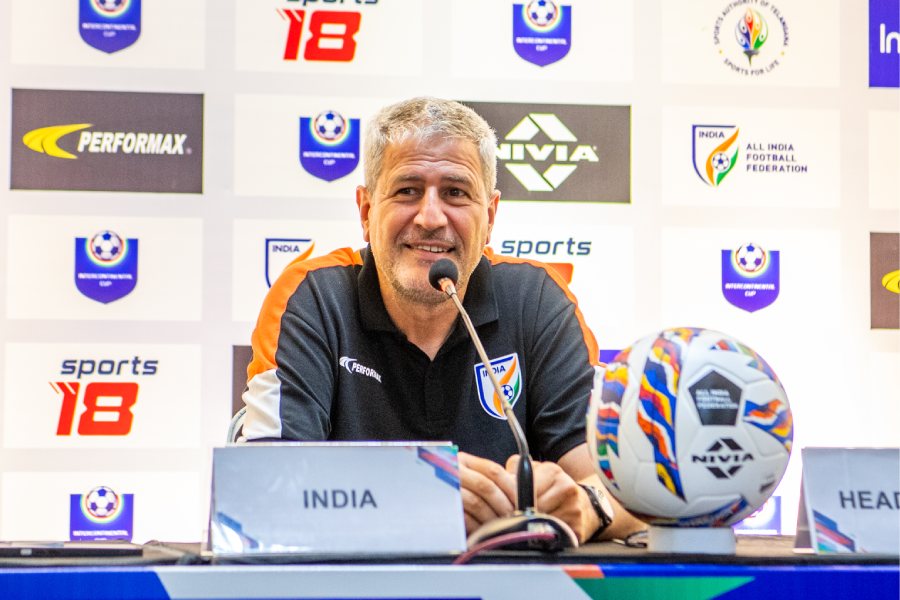
When Cheteshwar Pujara finished unbeaten at 145, having carried his bat through India's first innings at Colombo, his career Test average topped fifty. He is the only current Indian batsman to achieve this distinction and distinction it is. There's much about batsmanship that is unquantifiable but pundits and players alike agree that a fifty-plus average over a reasonable number of Tests bears witness to a first-rate batsman.
Cheteshwar Pujara is a first-rate batsman. He is 27 years old, he has played 27 Test matches and this should be his batting prime, but he is in this team on sufferance. Had either of the two first choice opening batsmen, Murali Vijay and Shikhar Dhawan, been fit, he would still be mooching around the margins of the squad, wearing the team bib and carrying drinks in for the men in the middle.
When he passed fifty in this innings, Sanjay Manjrekar asked Sunil Gavaskar if Pujara had done enough to regain his place in the team or whether he needed to clinch it with a hundred. Gavaskar's elaborately considered opinion was that in the current set-up, Pujara needed a 150 to be in serious contention. A century and a half...what team of Titans was this, what bastion of Bradmans was Pujara trying to breach?
When the Indian team came out to field, his lowly status in the team's pecking order was evidenced by his costume: he was wearing a helmet and shin guards under his trousers, a sure sign that he was the designated short-leg fielder. This scary position is generally reserved for the rookie in the team because no one wants to be maimed by a meaty pull. In a culture where seniority counts for a lot, that helmet and those guards told you how far Pujara had fallen. How had it come to this?
Career averages are a poor guide to current form. So while Pujara at fifty is ahead of Virat Kohli, Ajinkya Rahane and Dhawan (all clustered around the 45 mark) and well ahead of Murali Vijay and Rohit Sharma, his form since the tour of New Zealand in February 2014 has been poor. A couple of fifties in twenty innings is poor return for a batsman of his quality and middle-order comrades like Rahane and Kohli had hit a rich vein of form in Pujara's fallow period. Also Captain Kohli's decision to play five bowlers means there is one less batting place to go around. This meant that with Dhawan, Vijay, Rahane and Kohli being automatic choices, Pujara was competing with K.L. Rahul, who had distinguished himself in Australia with a century and that perennially promising talent, Rohit Sharma.
Rahul is a fine young batsman who managed two centuries in his first four Test outings, but his future in the Indian team clearly lies in one of the two opening slots. If Dhawan and Vijay stay fit and maintain their form, it's conceivable that he might challenge for the number three position, but it's hard to see him edging Pujara out in a head-to-head comparison, especially after Pujara's comeback hundred. Pujara's real rival in the middle order is the Mumbai batsman, Rohit Sharma.
Sharma is older than Pujara by a year, but to hear his admirers in the cricket establishment talk, he is a volcano of virginal talent, about to erupt. After two hundreds against the West Indies on debut, he has done little or nothing. If you compare Sharma's record against Pujara's since they last scored a hundred, Sharma averages a little over 25 and Pujara just over 26 and yet it was Pujara with much the better career record (Sharma averages 37 in 13 Tests) and unarguably the better Test match temperament, who was left out of the last Test in Australia, the Test against Bangladesh and the first two Tests of this Sri Lankan series. Pujara has had to smuggle himself into the team by the back door, as it were, by playing in the unaccustomed position of an opening batsman.
Meanwhile, Sharma has had a free run of the middle order. He was played at number three (Pujara's preferred place where he has played nearly all his Test cricket) till the first Test in Galle and when he failed there, Rahane was kicked upstairs so that Sharma could find a more sheltered billet at number 5. When Pujara was grinding through his massive innings at the SSC in Colombo, the commentary team, made up of Manjrekar, Gavaskar and Akash Chopra, came to the curious conclusion that Sharma was tailor-made for the number 5 spot because he could 'express' himself and play with the tail. Suddenly it was as if Sharma had some natural lien on the lower berth while Pujara would have to duke it out for a top order place with the likes of Rahul and Rahane or even one of the settled openers.
We've been here before. There was a time when V.V.S. Laxman was overlooked in favour of Yuvraj Singh, who was inferior to him by every measure known to Test match batsmanship. Yuvraj didn't like fast bowling and showboated when he should have knuckled down. But he periodically edged Laxman out because his patrons would talk up his attacking gifts or, all else failing, his ability to bowl left arm slows. And the reason why these arguments carried the day was because Yuvraj, like Rohit Sharma, had an advantage that neither Laxman (in his later career) nor poor Pujara could match: a place in the ODI squad.
Rohit Sharma is one of a long line of contemporary batsmen who play Test cricket because they look good playing ODI cricket. Sharma won his Test place on the strength of his spectacular displays as an ODI opening batsman and he has held in the expectation that his berserker ability to hit limited-overs double hundreds might rub off on his Test match form.
It is a truth increasingly acknowledged that a young man possessed of an ODI berth stands a better chance of holding down a Test match place than a young man without one. Pujara doesn't play limited overs cricket in any format for India and hasn't been able to find an IPL franchise that wants him. Rohit Sharma, in contrast, is a lion in Lilliput: the shorter the format, the better he gets. This counts against Pujara because while Sharma and others like him are constantly in the public eye because of the modern cricketing calendar, he is out of sight and mainly out of mind except when Test match cricket looms on the horizon.
The camaraderie that comes of constantly playing ODIs and Twenty20 cricket, the sense of always being in the mix, just never happens for Test match specialists like Pujara and the later Laxman. Multi-format players are buoyed up by their versatility; their teammates in these formats, their captains, their sponsors, want them to succeed. The force, so to speak, is with them. Someone like Pujara has to constantly make his own weather; the juggernaut of limited-overs cricket which underwrites the game has no interest in him.
To point this out is not to suggest that someone is to blame for this state of affairs; it is the way cricket has evolved and players like Yuvraj Singh and Rohit Sharma can scarcely be blamed for their good fortune. It is, simply, to ask for greater discrimination from the powers-that-be when it comes to picking Test teams.
It is not too much to ask that Test selectors be self-conscious about the dangers of allowing the stardust of limited-overs cricket to bedazzle them when they make their choices for the game's longest format. Nor is it conspiratorial to point out that Pujara's time in the wilderness had something to do with the fact that he belongs to an unfashionable cricketing province, Saurashtra. Saurashtra has great cricketing pedigree but it counts for nothing in the councils of the BCCI. Mumbai, of which Rohit Sharma is a native son, counts for a great deal.
It may well be that Test cricket is dying. Perhaps the empty stands in Colombo where Sangakkara played his last Test were a sign. If this is true - actually, especially if this is true - all the more reason to make sure that this great game is carried to its ghat by the right pall-bearers, by serious men.










